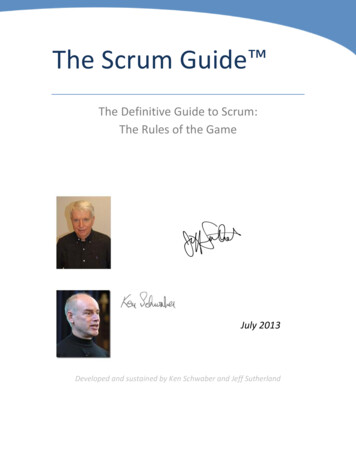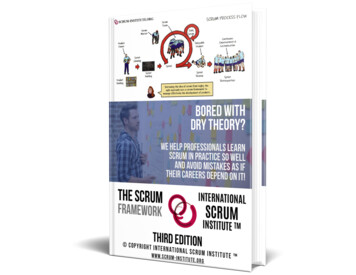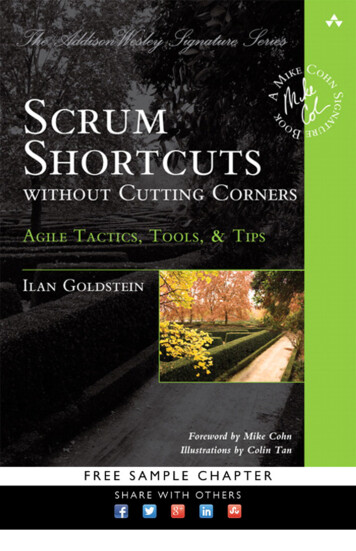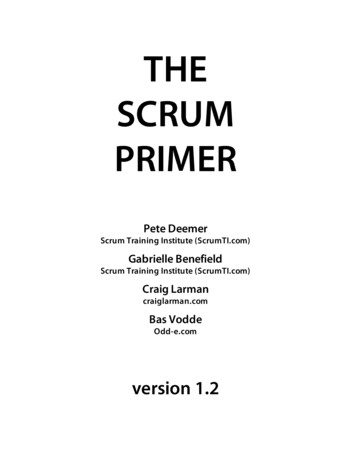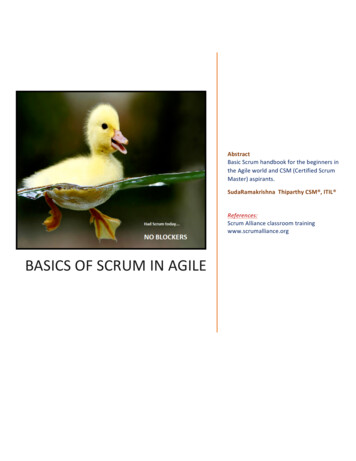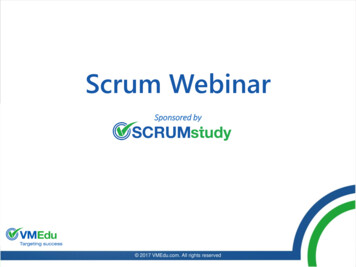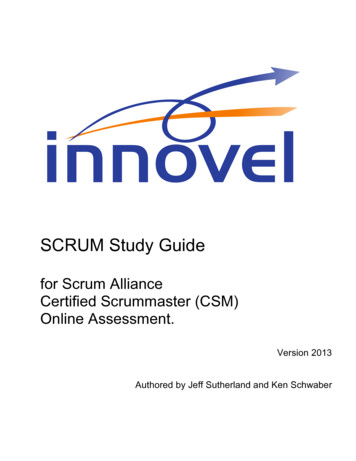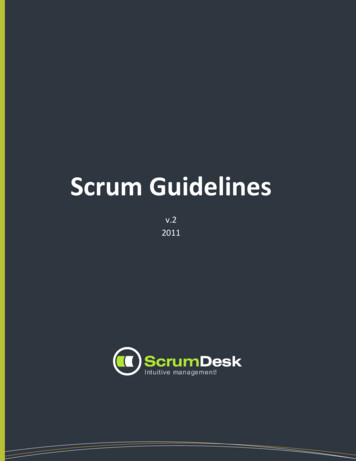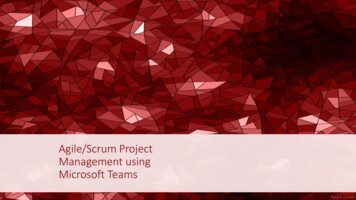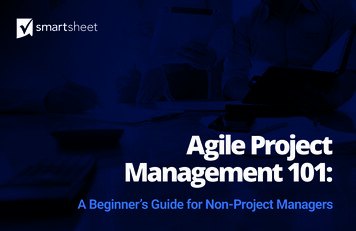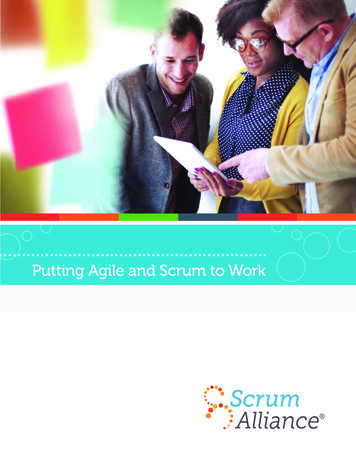
Transcription
Putting Agile and Scrum to Work
Want to transform your world of work?It’s possible with Agile and Scrum.This whitepaper will help you understand what Scrum is, how it works,and how it can enhance your own productivity to increase performance.What are Agile and Scrum?Agile is an approach for getting work done by thecollaborative effort of self-organizing and cross-functionalteams, encouraging flexible response to change.Scrum is an Agile framework that’s been used to managework on complex products since the early 1990s. Scrum isnot a process, technique, or definitive method. Rather, it’san outline to refer to while employing various processesand techniques.85% OF THE 2017-2018Teams complete tasks in set periods of time called Sprints,typically less than 30 days each, with daily reassessmentsSTATE OF SCRUMof progress and status. This approach is effective inRESPONDENTS SAY THATovercoming obstacles often presented by unexpectedSCRUM CONTINUESchallenges, including evolving customer input.TO IMPROVE THE QUALITYOF THEIR WORK LIFE.People aren’t happy because they’re successful.They’re successful because they’re happy.”– DR. JEFF SUTHERLAND, co-creator of Scrum2
What can Scrum andAgile do for me?TOP3nYou’ll be more productiven You’ll find that short-term goalsnWhat can Scrum and Agile dofor my company and projects?TOPn3 You’ll produce a higher quality of workat a lower cost (better ROI)are easier to manage and attainnYou’ll have higher customer satisfaction You’ll have the opportunity ton You’ll enjoy increased team collaborationmake more moneyand moraleFUN FACTThe term “scrum” comes from a 1986 Harvard Business Review article in which the authorsmade an analogy comparing high-performing, cross-functional teams to the scrum formationused by rugby teams.Companies are increasingly realizing that the old, sequential approach todeveloping new products simply won’t get the job done. Instead, companiesare using a holistic method — as in rugby, the ball gets passed within the team asit moves as a unit up the field.”–H IROTAKA TAKEUCHI and IKUJIRO NONAKA“New Product Development Game”Harvard Business Review3
How are Scrum and Agile different?The “WHY”Many organizations use a traditional top-down project management approach, also known as Waterfall.Despite the name, this technique is not always the most fluid way to go. Waterfall is more of a sequentialmethod; the stages of a project are worked on in a consecutive order, from conception, to design, toimplementation. The challenge with the Waterfall methodology is that once one step is complete, it’s almostimpossible to go back (and potentially improve) without scrapping the whole project. This approach costs timeand money.Enter the Agile approach. As the most widely used framework within Agile, Scrum is used to break downcomplex projects into smaller pieces, thereby allowing your team to continuously deliver value on a morefrequent basis. It’s a more collaborative and flexible approach, so you can respond to your client’s evolvingneeds and changes in the market. It’s common for customer needs to evolve throughout the course of anyproject, and the Scrum approach enables more adaptability.Basic Scrum Project Team RolesThe “WHO”ScrumMasterThe ScrumMaster helps the Scrum Teamperform at their highest level. They fullyunderstand the underlying principles ofScrum and can effectively apply themin complex, real-world situations. Theyensure that goals and scope of projects areclearly understood and work to removeimpediments to progress.Product OwnerThe Product Owner role is typically forthose who are closest to the “business side”of projects. They are expected to do thebest possible job of satisfying allstakeholders, maintain the Product Backlog,and ensure that everyone knows thepriorities.Development TeamDevelopment Teams are structured andempowered to organize and managetheir own work. The resulting synergyoptimizes the Scrum Team’s overallefficiency and effectiveness.4
How Scrum WorksThe “HOW”The Scrum FrameworkProduct BacklogDaily Scrum (or Daily Stand-up)The Product Backlog is the organization of itemsthat guides what’s most important to focus on andbuild next. The Product Backlog is constantly beingupdated and refined.Daily Scrum (think “daily status meeting”) is theheart of the framework. Daily Scrums highlightand promote quick decision-making, and theyimprove the Scrum Team’s level of transparency andknowledge. The Daily Scrum is short — averagingabout 15 minutes — so the team tends to be highlyfocused.SprintAt the heart of Scrum is the Sprint, during which ausable and potentially releasable product incrementis created. Sprints are usually one week to one monthin length, and happen one right after the otherto keep projects moving. There are three events(ceremonies) that happen with each Sprint:SPRINT PLANNINGThe team decides what to work on for the currenttime-boxed period.SPRINT REVIEWThe team collaborates about what was done andadapts the Backlog as needed.The Scrum Alliance DifferenceScrum Alliance — the largest, most established, andinfluential nonprofit professional membership andcertification organization in the Agile community— exists to transform the way we tackle complexprojects, bringing the Scrum framework and Agileprinciples beyond software development to thebroader world of work. Our mission is to guideand inspire individuals, leaders, and organizationswith practices, principles, and values that createworkplaces that are joyful, prosperous, andsustainable.SPRING RETROSPECTIVEThe team discusses what went right, what wentwrong, and how to improve.5
Why pursue a Scrum Alliance certification?We are committed to delivering the highest standards of education. Our more than 200 Certified ScrumTrainers go through an extensive set of peer reviews, testing, training, and interviews. Scrum Alliance trainingand certification is world renowned for its consistency, quality, innovation, and experienced instructors.Our certifications are globally recognized as evidence of the highest Agile and Scrum knowledge. Theydemonstrate your professional knowledge and can lead to higher earning potential. Companies chooseScrum to deliver more value to their customers and their bottom line. They have come to understandthe value that a Certified ScrumMaster , Certified Scrum Product Owner , or Agile Coach brings to theirorganization. And they’re willing to pay a premium.Improve your organization’s bottom line—and your own salary.Professionals who make the decision to adapt to Agile practices — andScrum in particular — are enjoying a higher income.According to the 2017-2018 Salary Survey of Scrum Professionals,sponsored by Scrum Alliance, 55% of Scrum professionals saw anincrease in their annual base salary from 2016 to 2017.In the U.S. alone, salaries usually start over 100,000 and move upward.THE REAL BENEFITS OFCERTIFICATION MEANYOU CAN n hange your mindset andChave the potential to help yourorganization succeedn inimize wasted effort,Mduplication, and resourcesn tay relevant and marketableSacross all industry sectorsadopting Agile practicesEUROPE 83,245NORTH AMERICA 116,544SOUTH AMERICA 56,751ASIA 70,254AUSTRALIAand OCEANIA 123,305* from the 2017-2018 Salary SurveyAverage annual base salaries* regionally (in USD)6
Scrum Alliance CertificationsWhen an applicant has a Scrum certification, we know that applicant willbe collaborative and a strong communicator, while being eager to improveprocesses or bring new ideas.”– TORRIE MICHAUDHR Director for BlueCross BlueShield of ArizonaThe two foundational certification paths start with Certified ScrumMaster (CSM )and Certified Scrum Product Owner (CSPO ).nA s a Certified ScrumMaster, you’ll help the rest of the Scrum Team work together to learn andimplement Scrum. Along with the Product Owner, you will work to protect your team from bothinternal and external distractions.nA s a Certified Scrum Product Owner, you’ll monitor projects, keep tabs on priorities, and makesure the best possible job is done to satisfy all clients (a.k.a. stakeholders).But it doesn’t stop there. You can advance your role-specific skills and evolve as a Scrum professional withan Advanced Certified ScrumMaster (A-CSMSM), Advanced Certified Scrum Product Owner (A-CSPOSM),Certified Scrum Professional -ScrumMaster (CSP -SM), and Certified Scrum Professional -Product Owner(CSP -PO), and more!The Path to Certified Scrum Professional 7
Why Scrum Alliance?nO ur global nonprofit association has focused on Agile transformation since 2001nW e have certified more than 750,000 practitioners in the global Agile communitynO ur high standards ensure superlative Agile leadership, guidance, and trainingHow can we help you?Learn more about certifications and opportunities available to you at scrumalliance.org. Scrum Alliance 20181250 E6
What are Agile and Scrum? Agile is an approach for getting work done by the collaborative effort of self-organizing and cross-functional teams, encouraging flexible response to change. Scrum is an Agile framework that’s been used to manage work on complex products since the early 1990s. Scrum
